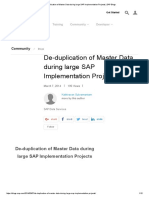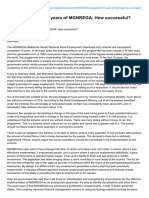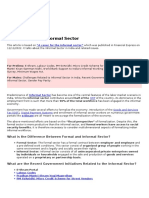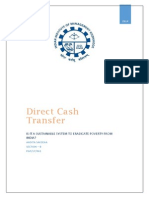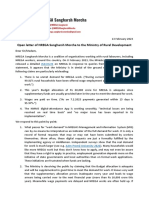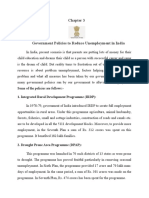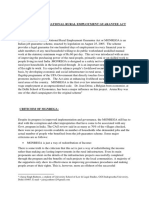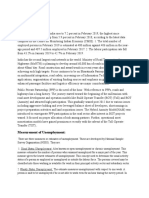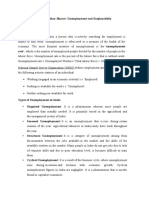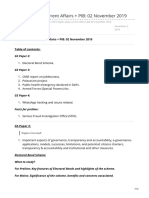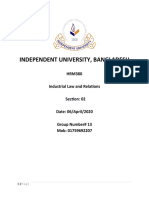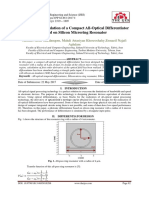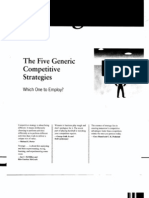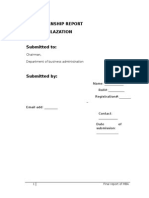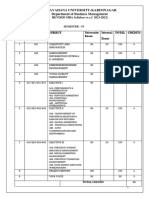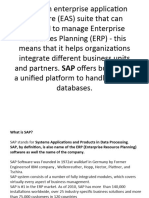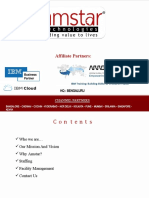G 0252050056
G 0252050056
Uploaded by
theijesCopyright:
Available Formats
G 0252050056
G 0252050056
Uploaded by
theijesOriginal Title
Copyright
Available Formats
Share this document
Did you find this document useful?
Is this content inappropriate?
Copyright:
Available Formats
G 0252050056
G 0252050056
Uploaded by
theijesCopyright:
Available Formats
The International Journal Of Engineering And Science (IJES) ||Volume||2 ||Issue|| 5 ||Pages|| 50-56||2013|| ISSN(e): 2319 1813 ISSN(p):
: 2319 1805
Overview of Information Technology Enabled Services for Efficiency and Effectiveness of Central Government Sponsored Schemes. Mgnrega In Kashmir A Case Study.
Mohammad Asif Naqshbandi
Assistant Professor School of Business Studies Islamic University of Science and Technology, Awantipora, Pulwama, Kashmir, INDIA
--------------------------------------------------ABSTRACT-------------------------------------------------------World IT spending in 2012 touched three thousand five hundred million US dollars and is expected to reach four thousand million this year. This amount is pintsized when compared to the value IT complements to the organisation through increased efficiency effectiveness and transparency. However government processes worldwide are still like a blue ocean where potential of information technology enabled solution have not been exploited yet. And the problem is more intense when it comes to diversified nations like India. All of us are witness to the fact that despite the availability of money, potential and other required resources our governance have never been able to achieve optimal levels of efficiency and effectiveness due to outcome of several factors like redundancy, improper time management, effective supply chain management and many more. MGNAREGA being one of the pioneering innovative and liberal schemes by government of India is suffering efficiency, effectiveness and transparency deficit. Even a one percent increase in efficiency would mean several thousand days of employment to unemployed and infrastructure up gradation. This research work will look forward to outline information technology services for effective and efficient MGNREGA in the state of Jammu and Kashmir.
I.
INTRODUCTION
World IT spending in 2012 touched three thousand five hundred million US dollars and is expected to reach four thousand million this year. This amount is pintsized when compared to the value IT complements to the organisation through increased efficiency effectiveness and transparency. However government processes worldwide are still like a blue ocean where potential of information technology enabled solution have not been exploited yet. And the problem is more intense when it comes to diversified nations like India. All of us are witness to the fact that despite the availability of money, potential and other required resources our governance have never been able to achieve optimal levels of efficiency and effectiveness due to outcome of several factors like redundancy, improper time management, effective supply chain management and many more. MGNAREGA being one of the pioneering innovative and liberal schemes by government of India is suffering efficiency, effectiveness and transparency deficit. Even a one percent increase in efficiency would mean several thousand days of employment to unemployed and infrastructure up gradation. This research work will look forward to outline information technology services for effective and efficient MGNREGA in the state of Jammu and Kashmir.
II.
INTRODUCTION TO MGNREGA
Enacted by the legislation on august 25, 2005 The Mahatma Gandhi National Rural Employment Guarantee Act (MGNREGA) is an Indian job guarantee scheme. The act guarantees a minimum of one hundred and fifty days of employment in every financial year to the members of any rural household who wish to do any unskilled manual public work at a fixed minimum wage. The government has the obligation to pay the registrants of the scheme at their home if they are not provided with any assignments. III. PROBLEM STATEMENT. The Mahatma Gandhi National Rural Employment Guarantee Act (MGNREGA) has significant impression on the financial condition of rural India by ensuring guaranteed employment or payoff. And besides that it has also helped in the development of infrastructure of villages. Being implemented by the Rural Development Department it ensures 100 days job for every house hold in rural India. .Under the scheme over 10.50 lakh job cards have been issued to the rural labour families during the last four year creating about 10 crore man-days of work for them by November 2012 end. However Figures from the official sources of MGNREGA clearly indicate higher inefficiency levels in the execution of the scheme in terms of demand
www.theijes.com
The IJES
Page 50
Overview Of Information Technology Enabled...
supply management, improper time management. The following figures clearly indicate the state of scheme. i:e out of 790000 job cards issued only 203819 have actually demanded employment. Only 196682 were provided employment out of which only 4645 have been given 100 days of employment by first week of December 2012 for current financial year with 65% funds still unutilized. The scheme is already in the scanner of the Comptroller Auditor General because of reports of misappropriation of funds .It will be pertinent to mention here that the High Court has served notices to officers and elected representatives of Doda district where MGNREGA had been allegedly misutilised. A public Interest Litigation filled by advocate SK Puri on behalf of general public in the Jammu High Court wherein it has been alleged that government officials, public representatives and affiliated officials with Mahatma Gandhi National Rural Employment Guarantee Act scheme have made it a money minting machine which is eroding the government exchequer, which was meant for poor people. The Public Interest litigation also alleges that under the Mahatma Gandhi National Rural Employment Guarantee Act officials and elected representatives had tapped money on the name of Special Police officers (SPOs), daily wagers, minors and even deceased persons. Citing the examples as the proof it states that
21%
79%
Only 21 % have actually demanded jobs out of total registered (2012)
one Noor Mohammad, son of Butta Kumar, who died on May 29, 2011 was marked present from November 21, 2011 and Rs 3,620 labour stand drawn in his favour as per information obtained from right to information act .Similarly, Paramvati Devi, wife of Prem Raj, who died on July 17, 2009 was marked from December 24, 2011 to January 7, 2012 in the attendance roll and 1815 were withdrawn in her favour.
Only 2 % of the employed have been provided 100 days of employment.(2012)
65% of Funds remain unutilized for state of jammu and Kashmir at year end (2012
www.theijes.com
The IJES
Page 51
Overview Of Information Technology Enabled...
A report Published by the National Level Monitoring ( A national agency mandated for regular monitoring of Rural development Programmes) after the exhaustive survey of almost all districts puts follows the following facts about the Mahatma Gandhi national employment guarantee act in Jammu and Kashmir. NLMs have found that in only 31.8% villages visited by them, awareness levels were good and all sections of the society were aware on provisions and features of MGNREGA. In39.2% villages, only few interested sections and the educated classes were aware of the provisions and features of MGNREGA. In almost 28.9% of the visited villages the awareness levels on MGNREGA were really poor. The spirit of the scheme guidelines for strengthening the wage seekers right to claim unemployment allowance if work is not provided within the stipulated time seems to have been diluted at the grass root levels. As it is in very few villages people demand work, orally on in writing and where they do, only in 17.8% villages, acknowledgement receipts are given to them. The practice of not acknowledging demand will weaken he guarantee element of the scheme and make this into a supply driven scheme also depriving the poor of the job opportunities during the lean periods and will fail the programme on its objective of curbing distress migration. It was found that in 20% villages, many Job card holders were not having Job Cards in their custody. In majority of the cases these Job Cards were with the PRI staff and functionaries and they reported that they have collected for updating the information have been willingly handed over to them by the job card holders. As per NLM reports, in only 45.1% villages, all the Job Cards checked were having photographs of all the registered members of household. In 5.9% villages, entries made in many Job Cards were not matching with the respective muster rolls. In 98.5% villages NLMs have reported delayed payment of wages. Extent of delay and frequency varies as much as the reasons for the delays. NLMs have reported that in only 1.4% villages dissent/objections were raised during the last social audit meeting and 1 issue raised/complaints were pending/not disposed of so far. It is evident that the provision of entitlement for minimum wages has not been complied in all the cases, in 5.9% villages NLMs have found instances of workers being paid less than minimum wage rates. Mostly these Villages are the ones where the payment to wagers are being made on piece rate basis and the reasons for being paid less than minimum wages is due to less output of work by the workers.
The above facts clearly indicate the efficient, transparency and timeliness deficit n the execution of the scheme. And besides that there are number of reports which have come from time to time reporting the misappropriations in the execution of Mahatma Gandhi National Employment Guarantee Act in the state of Jammu and Kashmir. Although it will be pertinent to mention here that a lot has been done to improve the execution of the scheme and same has improved a little however the nature of scheme being enormous in size makes sometimes difficult for all the stakeholders to be strict on deadlines and targets. How information Technology can be a remedy for the problem. Although the operations of Mahatma Gandhi National Employment Guarantee Act in the state of Jammu and Kashmir and whole country to an extent are computerised however its impact on the scheme is not as it should be. Every small of big business or government process is completely dependent on availability of adequate information at all the levels of management and is defined in terms of CATA test which means information at every level or point of management should be complete , adequate ,timely and accurate. Information technology enabled services have helped business organisations worldwide to qualify CATA compliant information at all the levels of management which in turn has helped the organisations to attain higher levels of efficiency and effectiveness. Information technology makes it possible through employment of various technologies ranging from cloud computing, hand held devices , satellite communication links , mobile phones to new cutting edge solutions like Business Intelligence, Knowledge management, real time supply chain management. However in the context of the current problem it will be very important to analyse the feasibility of solution in terms of IT literacy and technology infrastructure reediness. A brief survey of almost all the districts to analyse the technology infrastructure reediness reveals the following scenario.
www.theijes.com
The IJES
Page 52
Overview Of Information Technology Enabled...
Connectivity Type District RAJAURI KATHUA KISHTWAR REASI RAMBAN SAMBA KUPWARA KARGIL POONCH GANDERBAL BARAMULLA DODA BANDIPORA ANANTNAG LEH (LADAKH) KULGAM BADGAM PULWAMA UDHAMPUR SRINAGAR JAMMU SHOPIAN Total No.of Computer 5 12 0 0 2 10 42 0 36 13 4 14 4 4 0 4 3 5 15 0 31 1 205 Dialup 0 0 0 0 0 0 1 0 5 0 0 0 0 0 0 1 0 0 0 0 1 0 8 ISDN 0 0 0 0 0 0 0 0 0 0 0 0 0 0 0 0 0 0 0 0 0 0 0 VSAT 2 2 0 0 1 2 8 0 5 1 1 5 0 12 0 3 1 1 4 0 10 0 58 Broadband 2 0 0 0 0 0 0 0 1 1 0 2 0 1 0 1 0 0 2 0 0 0 10
Infrastructure Details of Block Headquarters and Block offices of all the districts of Jammu and Kashmir acting as primary point of contact of the scheme. It seems that the basic required infrastructure is available, in order to make optimal use of the resources other technologies need to be integrated with the scheme. The rest of the paper will focus on the available technologies that can transform the modus operandi of the national project.
Technologies as potential IT enabled services for MGNAREGA in Jammu and Kashmir. Business Process Reengineering/Government Process Reengineering for Information technology Adaptable Business process:To make any big or small business process completely information technology driven it is a prerequisite that the process should be adaptive to the technology implementation which ordinarily is not for majority of cases. In order to overcome the situation a new approach came into existence which primarily involves redesigning of whole business process to make it adaptive to technology implementation..
www.theijes.com
The IJES
Page 53
Overview Of Information Technology Enabled...
Figure Depicting Concept of Business Process Reengineering.
Business Process Reengineering does mean a dramatic change for a given organisation. It involves the overhaul of management systems, organizational structures, incentive systems employee responsibilities and performance measurements. When executed Business Process Reengineering has influence on the every dimension how business is being conducted today. A recent survey has showed that some 88 percent of CIOs were satisfied with the end result of Business Process Reengineering efforts (Motwani, et al., 1998). Successful Business process Reengineering can result in huge discounts in cost or cycle time. Business Process Reengineering has created substantial improvements in quality of service. The successes have spawned international interest, and major reengineering efforts are now being conducted around the world (Covert, 1997). Enterprise Resource Planning: Enterprise resource planning is technology driven system which ensures efficient/ optimal utilization of all resources for a given business process. Coined by Gartner group for the first time in 1990 it defines ERP as follows. Enterprise resource planning (ERP) is defined as the ability to deliver an integrated suite of business applications. ERP tools share a common process and data model, covering broad and deep operational end-toend processes, such as those found in finance, HR, distribution, manufacturing, service and the supply chain . Characteristics of an ERP (Enterprise Resource Planning) systems:
www.theijes.com
The IJES
Page 54
Overview Of Information Technology Enabled...
An incorporated system that operates in real time in synchronisation with Business Process. A common database, which caters to the needs of all the modules of an Enterprise Resource Planning system. An adequate Interconnectivity infrastructure which ensures flow of information and data across the modules. Common benefits of an ERP system:-
Common Modules of an ERP system.
Access to data for instant decisions Automated ordering and payment, lowering processing charges Improved customer response Improves the productivity of resources Increases organizational accountability and transparency. Inventory reduction Lead time reduction More controls thereby lowering the risk of mis-utilization of resources Data entry on real time basis Reporting according to global standards
However it is a completely new issue that weather ERP is to be procured for a particular process or manufactured for that particular process. Business Intelligence. Business intelligence (BI) is a set of theories, methodologies, processes, architectures, and technologies that transform raw data into meaningful and useful information for business purposes. BI can handle large amounts of information to help identify and develop new opportunities. Making use of new opportunities and implementing an effective strategy can provide a competitive market advantage and long-term stability Business intelligence solutions use data warehousing and data mining techniques to analyse huge information for extraction of strategic data. National Informatics Centre is providing services in the area of business intelligence solution to the government. The vital objective of Business Intelligence (BI) is to provide citizens with information along with analytical facilities so as to extract knowledge from the vast information base to enables them to make better decisions. The Business Intelligence system can help us to get the extracted information from vast government data through an integrated, centrally managed, and trusted data sources. Business Intelligence provides with the reporting and analysis tools and technologies to capture both structured and unstructured information. . Keeping the Scalability of mahatma Gandhi national employment guarantee act in mind, it is the scheme of huge data, funds, people, places and transactions and sometimes non availability of an analysed multidimensional extracted piece of information costs an organisation or a any business process a lot. Business intelligence is now a days used by organisations worldwide to device their strategies, future plans, and new enterprise systems.
www.theijes.com
The IJES
Page 55
Overview Of Information Technology Enabled... IV. CONCLUSION
Information technology enabled solutions are helping government process across India to operate the way they are supposed to operate in terms of transparency efficiency and effectiveness .We have very few schemes in India where we have resources but we are lacking it terms of improper planning or execution. It is an evident fact that Mahatma Gandhi national employment guarantee act is a scheme primarily targeted for rural India which forms the bigger part of India therefore making necessary for an project to be transparent, effective, timely and efficient in execution. We have come to there have been enormous facts of misappropriation in the execution in the state of Jammu and Kashmir therefore making it an most eligible process of government where the power of information technology enabled solutions could have been utilised up to the optimal level.
REFERENCES.
[1] [2] [3] [4] [5] [6] [7] [8] [9] [10] [11] [12] [13] [14] [15] http://nrega.nic.in/netnrega/home.aspx http://www.ndtv.com/topic/mgnrega http://www.nrega.nic.in/complaints/Helplinecomp/Jammu%20Kashmir.xls http://nrega.nic.in/netnrega/Data/State_brief_14.pdf http://jammu.greaterkashmir.com/news/2013/Mar/26/centre-slams-jk-over-poor-nrega-implementation20.asp http://164.100.72.25/netnrega/state_html/social_auditNT.aspx?v_code=14&v_name=JAMMU+AND+K ASHMIR&fin_year=2011-2012&page=S&Digest=vve4kVqMV5719pzm0kxaTA http://nrega.nic.in/circular/minutes_of_LB_meeting_01122011.pdf http://rural.nic.in/sites/national-level-monitors.asp http://www.ruralmonitor.in/nlm.aspx http://en.wikipedia.org/wiki/Enterprise_resource_planning http://www.webopedia.com/TERM/E/ERP.html http://www.eresourceerp.com/reason-for-ERP-market-growth-in-india.html http://www.backbonemag.com/Backblog/top-10-predictions-for-the-global-erp-industry-in-2013.aspx http://www.marketresearch.com/Netscribes-India-Pvt-Ltd-v3676/ERP-India-6576144/ http://webs.twsu.edu/whitman/papers/ijii99muthu.pdf
www.theijes.com
The IJES
Page 56
You might also like
- MB920 Learning PathDocument1 pageMB920 Learning PathseppNo ratings yet
- Project Failure in Software Industry of Bangladesh PDFDocument13 pagesProject Failure in Software Industry of Bangladesh PDFAryaan RazZNo ratings yet
- BSBMGT517 AssessmentDocument49 pagesBSBMGT517 AssessmentPatricia Borbe20% (5)
- Material Master Data CleansingDocument11 pagesMaterial Master Data CleansingmsukuNo ratings yet
- OptioDocument5 pagesOptiob0bb1No ratings yet
- OpenERPOdoo - An Open Source Concept To ERP SolutiDocument6 pagesOpenERPOdoo - An Open Source Concept To ERP SolutiSigit HartonoNo ratings yet
- LIMITATIONSDocument4 pagesLIMITATIONSSheryl PaulNo ratings yet
- Business Environment: Section E - Group 3Document40 pagesBusiness Environment: Section E - Group 3Aashish NagNo ratings yet
- MGNREGADocument3 pagesMGNREGAKiran Dl VarmaNo ratings yet
- Preface: Appraisal of Gram Panchayat Under MGNREGADocument15 pagesPreface: Appraisal of Gram Panchayat Under MGNREGAshoyeb_mohmmedNo ratings yet
- The Big Picture 10 Years of MGNREGA How Successful - 3Document2 pagesThe Big Picture 10 Years of MGNREGA How Successful - 3shiv161No ratings yet
- Analysis of Msme Finance in Context of Pmegp: Law and Economics Approach To Prospective NpaDocument8 pagesAnalysis of Msme Finance in Context of Pmegp: Law and Economics Approach To Prospective Npaindex PubNo ratings yet
- FLare June 2012 IssueDocument86 pagesFLare June 2012 Issuefarooq_flareNo ratings yet
- Research Paper On MgnregaDocument5 pagesResearch Paper On Mgnregaoyrzvcrif100% (1)
- Research Paper On Mgnrega PDFDocument5 pagesResearch Paper On Mgnrega PDFklbndecnd100% (1)
- Capacity Building For Micro EnterprisesDocument7 pagesCapacity Building For Micro EnterprisesAditya SharmaNo ratings yet
- ICT in NREGA Implementation: Possible Areas of ICT InterventionDocument4 pagesICT in NREGA Implementation: Possible Areas of ICT InterventionwkNo ratings yet
- Mahatma Gandhi National Rural Employment Guarantee ActDocument5 pagesMahatma Gandhi National Rural Employment Guarantee Actanon_689964215No ratings yet
- Ijcirv13n9 05Document16 pagesIjcirv13n9 05Muthu MuthuNo ratings yet
- Research Paper On Unemployment in India PDFDocument5 pagesResearch Paper On Unemployment in India PDFh03ch3b4100% (1)
- MGNREGA PAPER FinalDocument25 pagesMGNREGA PAPER FinalSuhail WaniNo ratings yet
- A Cover For The Informal SectorDocument4 pagesA Cover For The Informal SectorhyutNo ratings yet
- Government Policies To Reduce Unemployment in India ReportDocument7 pagesGovernment Policies To Reduce Unemployment in India ReportRizwan AkhtarNo ratings yet
- Mahatma Gandhi National Rural Employment Guarantee Act - Wikipedia, The Free EncyclopediaDocument3 pagesMahatma Gandhi National Rural Employment Guarantee Act - Wikipedia, The Free Encyclopediasubho21mukherjee4076100% (3)
- MGNREGA and Rural Distress in IndiaDocument10 pagesMGNREGA and Rural Distress in IndiainventionjournalsNo ratings yet
- ASS 2 A - Term - Paper - On - E-Governance - in - BRICS - CoDocument19 pagesASS 2 A - Term - Paper - On - E-Governance - in - BRICS - CoOluyiNo ratings yet
- AHS 546B (UNIT2) Sakshi Garg MSC 4thDocument5 pagesAHS 546B (UNIT2) Sakshi Garg MSC 4thSakshi GargNo ratings yet
- Ap 12-10-2022Document6 pagesAp 12-10-2022festivista.cessNo ratings yet
- Narega ReportDocument118 pagesNarega Reportthisismeamit20103094No ratings yet
- Indian Economy Assignment On NREGADocument6 pagesIndian Economy Assignment On NREGAVibhor Tekchandani100% (1)
- Direct Cash Transfer: Is It A Sustainable System To Eradicate Poverty From India?Document16 pagesDirect Cash Transfer: Is It A Sustainable System To Eradicate Poverty From India?Shilpi KumarNo ratings yet
- CAG Report On MNREGADocument344 pagesCAG Report On MNREGACanary Trap100% (1)
- Indian MSMEs - Another Year of Delayed Payments, Debt and StressDocument6 pagesIndian MSMEs - Another Year of Delayed Payments, Debt and Stressextraforextra99No ratings yet
- Research Paper On NregaDocument8 pagesResearch Paper On Nregac9rz4vrm100% (1)
- Budget Analysis India 2023 by DR Prabodh Halde CASMB 1675309626Document4 pagesBudget Analysis India 2023 by DR Prabodh Halde CASMB 1675309626ashish bidkarNo ratings yet
- MGNREGADocument3 pagesMGNREGAANKUR KASHYAPNo ratings yet
- Mgnrega ThesisDocument7 pagesMgnrega Thesisgbtrjrap100% (2)
- AG Detects Lapses in Implementation of NREGA in UPDocument9 pagesAG Detects Lapses in Implementation of NREGA in UPPawan ChandNo ratings yet
- Open Letter To MoRD, NREGA Sangharsh Morcha (English)Document2 pagesOpen Letter To MoRD, NREGA Sangharsh Morcha (English)The WireNo ratings yet
- Government Policies To Reduce Unemployment in India ReportDocument7 pagesGovernment Policies To Reduce Unemployment in India Reportketan bhereNo ratings yet
- BhenchodDocument7 pagesBhenchodHrishikeshNo ratings yet
- St. Mary'S Training College: Practical On Edu 402.2: Preparation &uploading of Journal ArticleDocument8 pagesSt. Mary'S Training College: Practical On Edu 402.2: Preparation &uploading of Journal ArticleClickon PeruvaNo ratings yet
- GS Paper 3Document73 pagesGS Paper 3Akhil ShastryNo ratings yet
- Informal Sector in IndiaDocument9 pagesInformal Sector in IndiaDiwakar SrivastavaNo ratings yet
- E-Governance-Emerging Dimension in India: Dr. Anuradha TyagiDocument6 pagesE-Governance-Emerging Dimension in India: Dr. Anuradha TyagiinventionjournalsNo ratings yet
- Impact of Digitalization On Indian Rural Banking CDocument12 pagesImpact of Digitalization On Indian Rural Banking CAnubhaNo ratings yet
- JPSP - 2022 - 282Document7 pagesJPSP - 2022 - 282Legal DepartmentNo ratings yet
- Yojana Magazine Broadening Base of E-Governance in IndiaDocument4 pagesYojana Magazine Broadening Base of E-Governance in Indiavivek559No ratings yet
- Guarantee Scheme With Special Reference To Hugli District of West Bengal"Document5 pagesGuarantee Scheme With Special Reference To Hugli District of West Bengal"theijesNo ratings yet
- Entrepreneurship CW1Document9 pagesEntrepreneurship CW1GOH SZE MENG JOYCELYNENo ratings yet
- NREGA Report FinalDocument13 pagesNREGA Report FinalAmit YadavNo ratings yet
- State Level Performance of MGNREGA in India A Comparative StudyDocument5 pagesState Level Performance of MGNREGA in India A Comparative StudyVENKY KRISHNANo ratings yet
- Jute Market Scan - 171210Document102 pagesJute Market Scan - 171210KrishnaRaoNo ratings yet
- Eco AssignmentDocument6 pagesEco Assignmentshashwat shuklaNo ratings yet
- Atma Nirbhar AssignmentDocument10 pagesAtma Nirbhar AssignmentAmandeep GargNo ratings yet
- Thesis On NregaDocument7 pagesThesis On Nregagj9ggjry100% (2)
- Impact of MGNREGA On Socio-Economic Development& Women EmpowermentDocument4 pagesImpact of MGNREGA On Socio-Economic Development& Women EmpowermentIOSRjournalNo ratings yet
- PhDentrance QN B Eco1Document3 pagesPhDentrance QN B Eco1Rajeev VermaNo ratings yet
- Information Systems For ManagersDocument8 pagesInformation Systems For ManagersmeghaNo ratings yet
- Daily Current Affairs PIB 02 November 2019Document12 pagesDaily Current Affairs PIB 02 November 2019HarishNo ratings yet
- Role of Panchayats in Planning and Implementation of Right To Work: A Study of MGNREGA in District Budgam in Jammu & KashmirDocument7 pagesRole of Panchayats in Planning and Implementation of Right To Work: A Study of MGNREGA in District Budgam in Jammu & KashmirEditor IJTSRDNo ratings yet
- MNREGADocument129 pagesMNREGASulthan Jose100% (1)
- A Study On The Role of Mgnregp-2005 in Irradicating Women Economic Stagnation With Special Reference To Mulakulam Grama Panchayath IndexDocument7 pagesA Study On The Role of Mgnregp-2005 in Irradicating Women Economic Stagnation With Special Reference To Mulakulam Grama Panchayath IndexRejitha Mol C.R.No ratings yet
- Independent University, BangladeshDocument13 pagesIndependent University, BangladeshNahin Ibn ZamanNo ratings yet
- Internet Plus Agriculture: A New Engine for Rural Economic Growth in the People's Republic of ChinaFrom EverandInternet Plus Agriculture: A New Engine for Rural Economic Growth in the People's Republic of ChinaNo ratings yet
- Defluoridation of Ground Water Using Corn Cobs PowderDocument4 pagesDefluoridation of Ground Water Using Corn Cobs PowdertheijesNo ratings yet
- Mixed Model Analysis For OverdispersionDocument9 pagesMixed Model Analysis For OverdispersiontheijesNo ratings yet
- Design and Simulation of A Compact All-Optical Differentiator Based On Silicon Microring ResonatorDocument5 pagesDesign and Simulation of A Compact All-Optical Differentiator Based On Silicon Microring ResonatortheijesNo ratings yet
- Influence of Air-Fuel Mixtures and Gasoline - Cadoba Farinosa Forskk Bioethanol Fuel Mixtures On Emissions of A Spark - Ignition Engine.Document9 pagesInfluence of Air-Fuel Mixtures and Gasoline - Cadoba Farinosa Forskk Bioethanol Fuel Mixtures On Emissions of A Spark - Ignition Engine.theijesNo ratings yet
- 01 - Case Study - Logistics 4.0 SCM in Industry 4.0 Era-2Document12 pages01 - Case Study - Logistics 4.0 SCM in Industry 4.0 Era-2shrushro123No ratings yet
- Audit On ERP Implementation UN PWCDocument28 pagesAudit On ERP Implementation UN PWCSamina InkandellaNo ratings yet
- SAP Indirect vs. Digital Access: White PaperDocument17 pagesSAP Indirect vs. Digital Access: White PaperyouminNo ratings yet
- International Business ManagementDocument14 pagesInternational Business Managementmapas_salemNo ratings yet
- Five Generic Business Level Strategies Thompson Et Al Chap5Document28 pagesFive Generic Business Level Strategies Thompson Et Al Chap5chirag_arora_1100% (1)
- Erp Versus CmmsDocument40 pagesErp Versus Cmmsparwaz_kamalNo ratings yet
- ExerciseDocument5 pagesExerciseParthNo ratings yet
- DBMS BSC V Sem 31-Dec-2020 Unit-5 Complet Pages 178 N1Document178 pagesDBMS BSC V Sem 31-Dec-2020 Unit-5 Complet Pages 178 N1Saradhi PkmNo ratings yet
- Hotel Management Software: ERP Software For HotelsDocument28 pagesHotel Management Software: ERP Software For HotelsShaikh MuzammilNo ratings yet
- Oracle Utilities Work and Asset Cloud Service: Overview Guide Release 18.2Document12 pagesOracle Utilities Work and Asset Cloud Service: Overview Guide Release 18.2Huzaifah MohdzainudinNo ratings yet
- CooperDocument7 pagesCooperSanaSyedNo ratings yet
- Icici Bank Project ReportDocument50 pagesIcici Bank Project ReportSurendra RatiwalNo ratings yet
- POM Unit 4Document16 pagesPOM Unit 4techworkpressNo ratings yet
- Marketing Plan Outline: Business MissionDocument15 pagesMarketing Plan Outline: Business MissionthienNo ratings yet
- Key Risk Factors in ERP ImplementationDocument4 pagesKey Risk Factors in ERP ImplementationHemanth19591No ratings yet
- Mba Internship Report RevisedDocument62 pagesMba Internship Report RevisedMuji_MSNo ratings yet
- Knowledge Map of Tally - Server 9Document30 pagesKnowledge Map of Tally - Server 9Rajesh KhaterNo ratings yet
- SyllabDocument17 pagesSyllabVibhavari MNo ratings yet
- WHO - Guideline Validation Computerized Systems-Appendix5 QAS16-667Document27 pagesWHO - Guideline Validation Computerized Systems-Appendix5 QAS16-667ppiccoliniNo ratings yet
- Quality Engineer Production Control Manager in Houston TX Resume Cynthia SheplerDocument3 pagesQuality Engineer Production Control Manager in Houston TX Resume Cynthia SheplerCynthiaSheplerNo ratings yet
- Presentation Sap Finance Accounting PPT 10 Nov 2019 1602025584 399083Document40 pagesPresentation Sap Finance Accounting PPT 10 Nov 2019 1602025584 399083GAJENDRA SINH CHHASATIANo ratings yet
- Amstar StaffingDocument14 pagesAmstar StaffingSunil SNo ratings yet
- Boileau Resume - CVDocument8 pagesBoileau Resume - CVboil35No ratings yet
- North South University: School of Business and EconomicsDocument36 pagesNorth South University: School of Business and EconomicsMehrab Jami Aumit 1812818630No ratings yet
- Sap Simple Finance Interview QuestionsDocument3 pagesSap Simple Finance Interview QuestionsMOORTHYNo ratings yet



